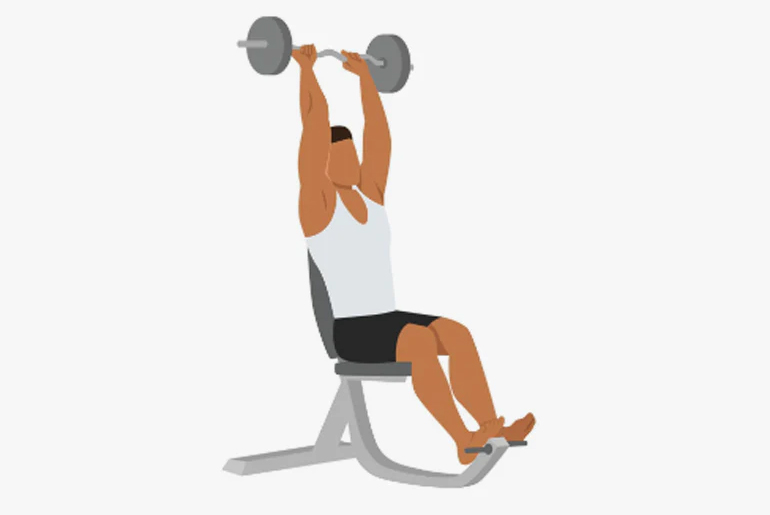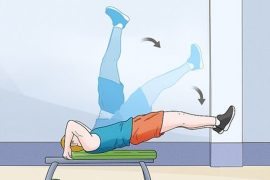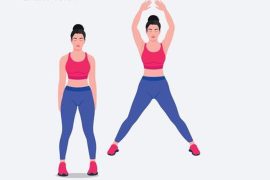Everyday activities, such as pushing heavy doors and lifting objects, rely heavily on strong triceps. To build and maintain these essential muscles, incorporating specific exercises is key. Workouts like triceps dips and diamond push-ups are effective bodyweight moves that target this muscle group, while the French press—performed with equipment like dumbbells, barbells, or an EZ curl bar—offers an alternative way to focus on triceps strength by extending the weight overhead while seated or standing at an incline.
French press:
The French press is an exercise specifically designed to isolate and strengthen the triceps. It involves extending your arms overhead with a dumbbell, barbell, or EZ curl bar, lowering the weight behind your head in a controlled manner, and then pushing it back up to the starting position. This exercise effectively tones the triceps and can be performed by both experienced lifters and beginners—with proper caution—to enhance arm strength and stability.
The French press exercise primarily targets the triceps brachii, with support from stabilizing muscles:
Muscles worked during the French press exercise
- Triceps brachii – The primary muscle responsible for elbow extension. It is the largest arm muscle, as noted in a 2020 study published in Frontiers in Physiology.
- Shoulders (Deltoids) – Act as stabilizers in the overhead position.
- Upper chest – Assists in stabilizing the weight, though not a major muscle in this exercise.
- Core muscles – Engage to maintain balance, especially when using heavier weights.
This makes the French press an effective triceps isolation exercise, with additional benefits for shoulder stability and core engagement.
Benefits of the French Press Exercise
- Strengthens Triceps – This exercise effectively isolates the triceps, increasing muscle mass and strength in the upper arms. Stronger triceps enhance performance in exercises like bench presses and push-ups.
- Tones Arms – Regular practice helps define and sculpt the triceps, making the arms look more toned and aesthetically appealing.
- Improves Posture – Engaging the triceps and shoulders enhances upper body strength and shoulder stability, leading to better posture. According to a 2008 study in Manual Therapy, good posture helps reduce muscle stress and lowers the risk of injury.
- Promotes Joint Stability – Strengthening the muscles around the elbow and shoulder improves joint stability, which is crucial for daily movements and other strength-training exercises.
This makes the French press an excellent triceps-focused exercise with additional benefits for posture, stability, and overall upper body strength.
Difference Between the French Press and Skull Crusher
While both exercises primarily target the triceps, they have key differences in execution and muscle engagement:
Arm Positioning
- French Press: Arms are positioned overhead, emphasizing the long head of the triceps.
- Skull Crusher: Arms are extended forward, parallel to the floor, placing more focus on the lateral and medial heads of the triceps.
Grip Style
- French Press: Can be performed with a barbell, dumbbells, or an EZ curl bar.
- Skull Crusher: Typically performed with an EZ curl bar for better wrist positioning.
Elbow Alignment
- French Press: The movement is more vertical, creating a deeper stretch on the long head of the triceps.
- Skull Crusher: The angle is more horizontal, distributing tension differently across the triceps.
Which One to Choose?
- If you want to maximize long head activation, go for the French Press.
- If you prefer a more balanced triceps workout, the Skull Crusher is a great choice.
- Combining both in your routine can lead to stronger and well-developed triceps.
How to Perform the French Press Exercise Correctly
- Starting Position: Sit on an inclined bench or stand upright with a dumbbell, barbell, or EZ curl bar in both hands. Hold the weight overhead, arms fully extended, with elbows close to your head.
- Lowering Phase: Slowly lower the weight behind your head by bending your elbows. Keep your elbows stationary and close to your ears to ensure proper triceps activation. Avoid overstretching to prevent unnecessary strain on the shoulders.
- Lifting Phase: Press the weight back to the starting position by extending your arms. Contract your triceps at the top for maximum activation.
- Breathing Technique: Inhale while lowering the weight. Exhale while pushing it back up.
Tips for Proper Form:
- Keep your core engaged to maintain stability.
- Use controlled movements—avoid jerking the weight.
- Start with a lighter weight to master form before progressing.
This exercise is highly effective for isolating the triceps and improving upper body strength!
Common Mistakes to Avoid While Doing the French Press Exercise
Flaring Elbows
- Keep elbows tucked in to properly target the triceps.
- Avoid letting them flare out, as this can reduce effectiveness and strain the shoulders.
Jerky Movements
- Perform slow, controlled reps to maximize muscle engagement.
- A 2011 study in The Journal of Physiology suggests slow movements enhance muscle growth.
Lifting Too Much Weight
- Using excessive weight compromises form and increases injury risk.
- Beginners should start with 4.5 – 5 kg and gradually progress.
Overstretching
- Lowering the weight too far behind the head can strain the shoulders.
- Maintain a comfortable range of motion to avoid joint stress.
Side Effects of the French Press Exercise
- Joint Strain: Improper form or excessive weight can cause elbow and shoulder strain.
- Shoulder Discomfort: Those with shoulder injuries should use lighter weights or modify the exercise. Consulting a fitness trainer can help ensure safe execution.
By maintaining proper technique and avoiding common mistakes, the French press remains one of the best exercises for triceps strength and upper body development!
Disclaimer:
The information contained in this article is for educational and informational purposes only and is not intended as a health advice. We would ask you to consult a qualified professional or medical expert to gain additional knowledge before you choose to consume any product or perform any exercise.






